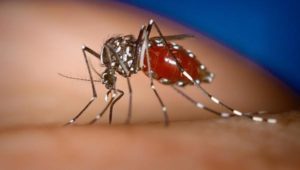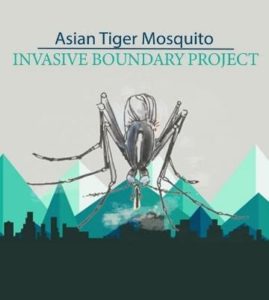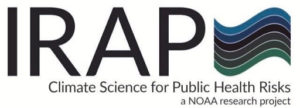By Kellyann Baxendell and Laura C. Harrington
Aedes albopictus, also known as the Asian tiger mosquito (ATM), is a species of mosquito originally from Asia. It was introduced to the USA in the mid-1980s and has become invasive across a wide swath of the eastern USA, with a continually expanding range. The ATM has distinct physical characteristics, including a single white line behind its head (thorax) and white stripes on its legs and body. This mosquito is also dark black in color, and this, combined with the distinct white lines, makes it an easy species to visually identify.

An Asian tiger mosquito female taking a blood meal, courtesy of NEVBD
ATMs are known as “container-breeding mosquitoes” because the females tend to lay their eggs in natural (i.e. a plant or tree hole) or artificial (i.e. a rain collection bin) containers that collect water. Since females like to lay their eggs in artificial containers, they are common in urban environments. The female lays the eggs just above the water line in the container, and, after a period of drying, the eggs are flooded when the container collects water, like rain. Once flooded, the eggs hatch into immature stages (larvae) in the water. The larvae turn into pupae and the pupae become adults. The ability of ATM eggs to survive outside of water in their dry period is why this mosquito is so invasive globally. These dry eggs can travel long distances on cargo, like old tires. Female mosquitoes use a sticky glue-like material to paste the eggs in the containers, and this glue keeps eggs on the containers so they can travel very well. Once at their new location, the eggs will hatch the next time they get flooded with water and introduce a new group of Asian tiger mosquitoes to this location. In total, the entire development from egg to adult depends on the ambient temperature. It can take as little as 7 days or as long as two weeks from egg hatch to adult in more temperate areas in the summer.
ATMs are particularly aggressive mosquitoes that like to bite during the day, so they can be incredibly annoying to individuals like gardeners and landscapers, who spend time outdoors in environments where the mosquitoes are present. These bites are known as “blood meals,” and they are only taken by female mosquitoes because they require the nutrients in the blood to make their eggs. In addition to being a nuisance, the ATM is also an important public health threat. It is a disease vector in the Northeast region of the US, meaning that the ATM can pick up a disease agent ( i.e. a virus) in one blood meal and give it to another individual it bites at a later time. In the Northeast, the ATM can potentially transmit diseases like West Nile Virus, Eastern equine encephalitis (“Triple E”), and dog heartworm. It can also transmit tropical diseases in more southern regions, like dengue, Zika, and chikungunya. It is important to always wear an insect repellent with an EPA-approved active ingredient, like DEET, Picaridin, or oil of lemon eucalyptus, to protect yourself from mosquito bites whenever you are outdoors. It is also important to dump standing water and clean rain gutters once per week to disrupt the ATM life cycle and stop a population from establishing in your yard.
 The invasive nature of the ATM in combination with its disease transmitting capability has prompted researchers to track its northern range. Currently, scientists at Columbia University and Cornell University are trying to map the northeast boundary of the ATM in the US using climate tools and a citizen science project administered by the Northeast Regional Center for Excellence in Vector borne Diseases (NEVBD). Understanding where this mosquito is, helps scientists focus on research and control efforts that may help us stop the spread of diseases.
The invasive nature of the ATM in combination with its disease transmitting capability has prompted researchers to track its northern range. Currently, scientists at Columbia University and Cornell University are trying to map the northeast boundary of the ATM in the US using climate tools and a citizen science project administered by the Northeast Regional Center for Excellence in Vector borne Diseases (NEVBD). Understanding where this mosquito is, helps scientists focus on research and control efforts that may help us stop the spread of diseases.
Since the northeast region of the US is vast, the NEVBD is relying on community members living in the potential boundary region to engage with our citizen science project and help us track the ATM. Project participation involves building mosquito traps out of used soda bottles and placing them in yards to collect eggs. Since the ATM is a container-breeding mosquito, these soda bottle traps make an ideal breeding habitat, and the trapping process mimics the natural cycle of the wet and dry periods necessary for mosquito maturation. The eggs mature into adults in the self-containing trap, so no new mosquitos are introduced into the trap area. Importantly, since the mosquitoes from the trap will not have taken any blood meals, they will not be capable of exposing the project participant to any diseases if one escapes. We hope that landscapers will help us find the ATM by participating in this citizen science project. If you would like to help us find out if the ATM is in your community, please visit the project website to download the trap-making guide and learn more about the ATM!
 This project is part of a larger endeavor on the development of climate-informed decision-support tools for the prevention of Aedes-borne disease in the US through Columbia University’s Earth Institute, funded by the International Research and Applications Program (IRAP) of the National Oceanic and Atmospheric Administration (Award NA18AOR4310339). Visit the IRAP project website for more details!
This project is part of a larger endeavor on the development of climate-informed decision-support tools for the prevention of Aedes-borne disease in the US through Columbia University’s Earth Institute, funded by the International Research and Applications Program (IRAP) of the National Oceanic and Atmospheric Administration (Award NA18AOR4310339). Visit the IRAP project website for more details!
About the authors
Kellyann Baxendell is a Master of Public Health student at Cornell University concentrating in infectious disease epidemiology. She graduated from Colgate University in 2018 with a bachelor’s in biology and has worked in the clinical pathology lab at the Cornell College of Veterinary Medicine for the past two years. As part of the MPH program, students are required to partner with public health organizations for an applied practice experience, and Kellyann has partnered with the Northeast Regional Center for Excellence in Vector-borne Diseases to manage their Citizen Science project tracking the Northeast boundary of the Asian Tiger mosquito.
Laura Harrington is a Professor in the Department of Entomology at Cornell University and Director of the Northeast Regional Center for Excellence in Vector Borne Diseases. She earned her MS from North Carolina State University and then worked in industry as an agricultural biologist developing bio-rational pesticides for BAS. She went on to complete her Ph.D. in Entomology with a focus on mosquito biology and public health from the University of Massachusetts and she completed her postdoctoral training at the University of California at Davis. Professor Harrington’s research focuses on the biology, ecology, and behavior of mosquitoes that transmit human diseases.

